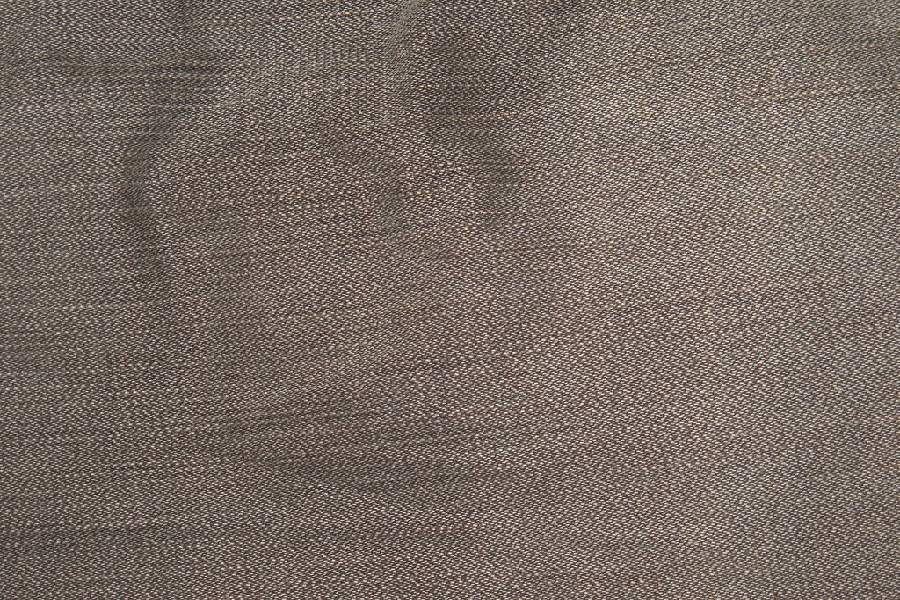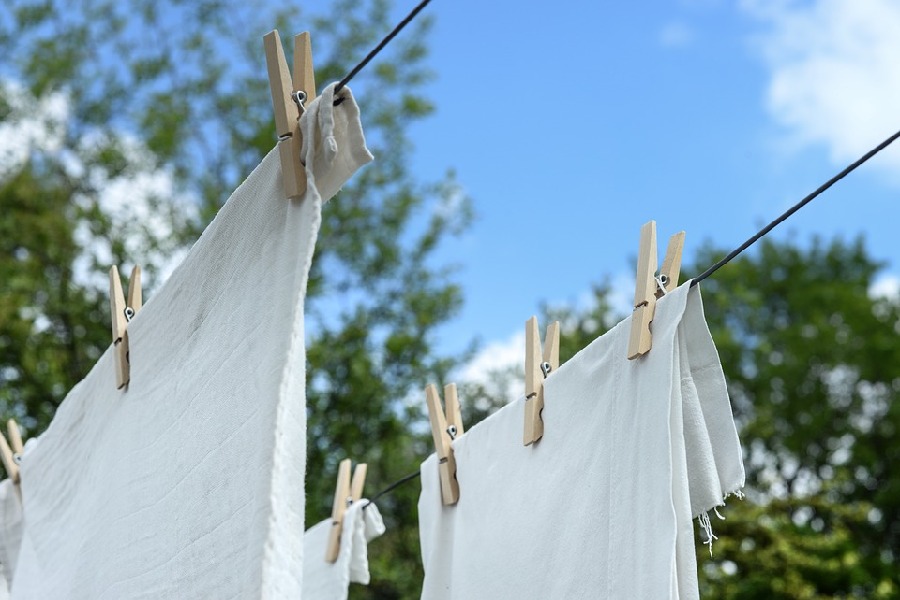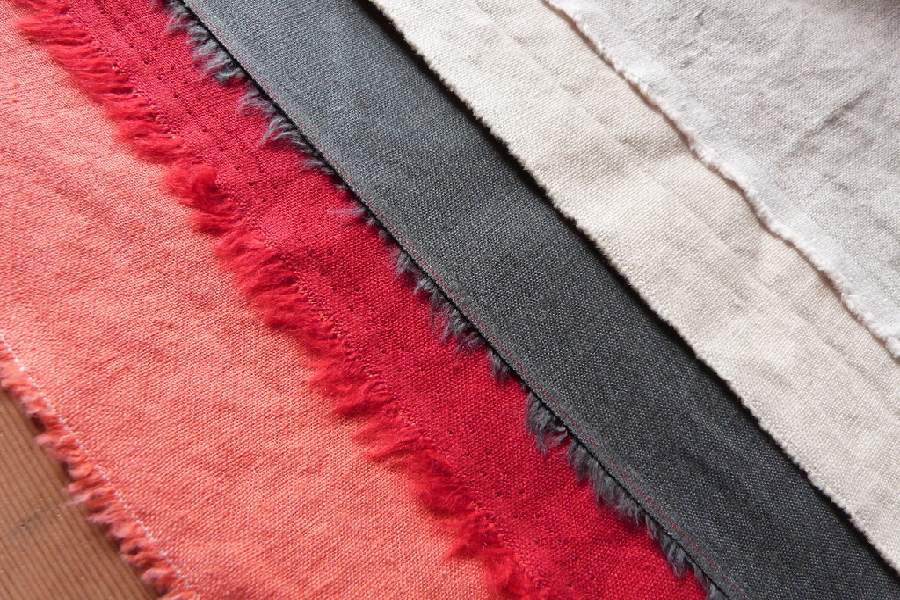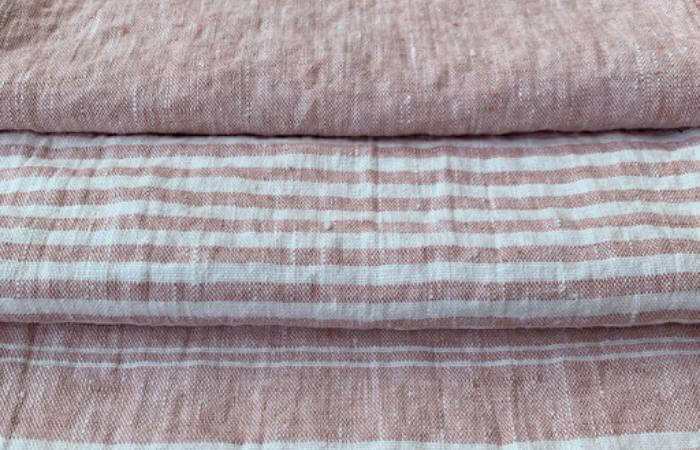You bought some lovely linen clothes because they look classic. But there’s something that keeps bothering you: Does linen shrink when they’re washed?
If you wash your best linen dress or shirt and then try to wear it again, you might find that it has lost its shape. It can be upsetting to find out that the wrong way of washing it caused it to shrink more than imagined. You’re not the only one who has to deal with cloth shrinking, sometimes by as much as 4% of its original size!
But there is hope! Read our full guide to learn why and how cloth shrinks after being washed and dried. Even more importantly, use our useful tips to keep your linen clothes as clean as the day you got them. Find out how to properly clean and care for your linens.
What Is Linen Fabric?
Linen, a 100% natural fabric, comes from fibers derived from the flax plant growing in cooler areas all over the world. The flax plant was popular in ancient Greece, Egypt, and Mesopotamia. It is thicker than other cotton textiles and is famous for its strength and durability.
People often use this fabric to manufacture shirts, bedding, jeans, and many more items. Unfortunately, while the material’s natural fiber is absorbent and has a sturdy fiber structure, it loses its elasticity over time, making it challenging to keep the fabric appearing fresh and vibrant.

Does Linen Shrink When Washed?
One of the characteristics of this fabric is that it gets softer with every wash. Even though the cloth relaxes, it may shrink when laundered if you don’t utilize the proper settings. But it’s not the only fabric with this trait. Have you ever wondered how other materials behave? Or perhaps, Does Linen Stretch? It’s essential to understand the full range of a fabric’s characteristics.
The most common cause of linen shrinkage is washing, although all materials should have guidelines on how to treat them to avoid shrinkage and damage.
Can you wash linen clothes thoroughly?
The water temperature has the most potent effect on linen shrinking when laundered. This fabric might contract if the temperature of the water is too high or too cold. Intense temperatures can cause the fibers to stress or be damaged, prompting the cloth to shrink.
Although cold water does not trigger much compression as hot water, the cloth may compress more than usual. If the water temperature is excessively high when you first wash linen your clothing, it might compress by as much as 10%.
Warm and cool water is the ideal temperature for soaking linens. The fibers will be less likely to be damaged under these conditions.
Can your machine wash linen?
In most cases, the fabric contracts in the washing machine. The biggest shrinking will occur if you launder it for the first time with either excessively cold or hot water.
This fabric will not compress after being cleaned without any further contact with the washing machine. If you aren’t cautious, its quality will decrease each time you launder.

Does Linen Shrink When Dried?
Drying linens, like washing them, can make them shrink. Using high heat to dry linen fabrics brings out the same effect as hot water. The fibers may compress and perhaps break down if the dryer level is too hot. You need to apply low or even no heat to dry linen fabrics.
Can you use a dryer on linen clothing?
You may dry linens in the dryer. Yet, you must be attentive not to overdry them. The most common cause of shrinkage is extended exposure to high heat.
How much does linen shrink in the dryer?
In the dryer, the fabric might shrink by 5%. When you factor in the amount of shrinkage that might occur in the washing machine, your linens could contract by 10% to 15% just.

Why Does Linen Shrink?
This fabric has plant-based textures. When you water a tree excessively, it becomes weak and less robust than it used to be. As the fiber gets wet because of relaxing shrinkage, the same effect occurs. The fibers also relax when they come in contact with water.
Moreover, the high heat may easily ruin linen. Linens shrink much more when washed in hot water because of the added moisture and heat. For this reason, it is often advised that laundry be washed at lower temperatures.
Because the fibers are much thinner and smaller than a tree stem, it is challenging for them to recover to their former form if they get too loosened. This fiber is more prone to shrivel when rinsed in hot water because both water and severe temperatures can make it compress.
Some fabric manufacturers pre-shrink the linen to prevent it from shrinking. Even pre-shrunk fabric, however, is susceptible to shrinkage. To ensure your linen garments and items retain their shape and size, it’s essential to follow care instructions closely. With the right care, you can enjoy the timeless beauty of linen for years to come!
Read more: Does Linen Stretch? 4 Circumstances

How To Properly Wash Linen ?
Linen clothes can shrink when washed. Fortunately, you can reduce the shrinkage proportion by following the steps below:
Before you wash linen:
If your linen clothing has a stain or blemish, try fixing it before laundering it. Quickly wipe the stain with an appropriate stain remover such as vinegar or baking soda. Also, check the color fastness on a non-visible spot first.
Before washing your clothing, you should review the label directions because:
- Linen performs well with various dye colors and blends well with other fabrics, giving it a lot of flexibility in the wardrobe. However, these hybrid textiles may necessitate special attention.
- Pre-washed linen fabric is less prone to shrink when rinsed. However, it’s still critical to adhere to the specified temperatures.
- While you can put pure linen fabric in the washing machine, additional materials for lining, trim, or stitching may need to be dry cleaned, or hand washed.
- Linen garments of lower quality may not launder as well as nicer linens. Your clothing will last longer if you get them from a reliable supplier who uses high-quality fabric.
Washing linen tips
After checking your clothing carefully, it’s time to wash it. Here are a few tips to follow:
Machine wash
Always use the medium mode and mild detergent on your washing machine for laundering linens. If the level of water in the machine is adjustable, set the highest option available. Your clothing should be able to move freely.
Don’t jam too many items into the machine at once. It might cause the cloth to distort or pull out of form. Make sure that other linen items in the machine have the same weight, color, and cleaning instructions as your linens.
Hand wash
When hand-washing linens, employ a gently rubbing motion rather than squeezing, twisting, or scrubbing the cloth. Hand washing is advisable for lightly dirty clothing and linen fabrics with a loose texture. Machine washing may destroy the texture.
Water temperature
It would help if you washed linen clothes with warm water. If you wash it in hot water, it shrinks. A range above 100°F is terrible for your clothing. If your clothes are vintage or have not been pre-washed, they will compress after the first washing, regardless of the water temperature.

How To Properly Dry Linen ?
If you know how to take care of your linen clothes, they will last for many years. They are a long-term option for fashion trends.
You can try these tips for drying linen to expand its longevity:
- It is okay to tumble dry any clothing if it is pre-washed products.
- Reduce the drying temperature to a low setting and extract the item while it’s still wet.
- Always attempt to dry your linen clothes evenly in the air. Racks and clothespins can leave marks on the clothing and cause it to break its form.
- We prefer the natural folds in linen fabric, but make sure it’s still moist when you start if you want to iron it.
How To Unshrink Linen?
How effective you are in regaining the fabric to its proper shape depends on how much it has shrunk. Linen fabrics that have shrunk just 3 to 4% of their former size have a greater possibility of returning to their former shape with little assistance.
If the fabric has shrunk by 10% or 15%, you may be able to erase part of the shrinkage, but it is pretty unlikely that it will recover its form.
To unshrink your clothes, you need to prepare these tools:
- A washtub
- A clothesline or drying rack
- Iron
- Ironing board
- Ruler
After gathering all the necessary tools, follow the instructions below:
- Before trying to unshrink the cloth, measure its dimension using the ruler. This step is optional. Yet, it can assist you in evaluating whether your efforts were eventually successful.
- Fill the tub halfway with warm water and set it aside. Please note that hot water will cause the linen fabric to shrink even more.
- Leave your clothing in the tub for 10 minutes. Don’t soak it for too long because the cloth may compress even more.
- To drain extra water, carefully squeeze the cloth. Using too much tension on the fabric will break the fibers, so don’t wring it out.
- Hang the clothes on a clothesline, a drying rack, or somewhere else where they may dry naturally.
- Don’t allow the cloth to completely dry. It should be damp so that you can unshrink it easier.
- Wait for about 20 minutes until the linen clothing is partially dry. If you dry it on a hot day, the time should be less.
- Take the moist cloth off the rack and iron it evenly over an ironing board.
- Start in the middle and move outwards over the width and length. This method of ironing encourages the cloth to expand.
After you’ve completed ironing, check the fabric’s dimension to determine if you effectively unshrink it.
However, depending on how compressed the cloth was in the first place, it may not totally recover to its original form. A simple approach to unshrink linen fabric is to dampen it using a spray bottle filled with warm water if you’re busy. Then, iron it following the instructions above.
This tip saves you the trouble of soaking the linen in water and then waiting for it to dry naturally. If you’re ironing multicolored linens, you might want to use a pressing towel to prevent the hue from fading.

7 Alternatives To Linen
There are many fabrics you can use in your daily life, including linen. If you are looking for alternative comforters, towels and bedding, there are many options. Here are some popular ones:
- Cotton: Cotton bedding and towels are timeless classics because of their softness and breathability. They are not only more comfortable than linen, but also require less maintenance.
- Bamboo cloth is known for its suppleness and ability to wick away moisture efficiently, making it an environmentally-friendly option. Hypoallergenic bamboo can also benefit people with sensitive skin.
- Polyester: Polyster can be combined with other fabrics to improve its properties such as resilience and wrinkle-resistance. Its quick drying time is also an advantage in some situations.
- Tencel bedding: Made from wood pulp, Tencel bedding is soft and absorbent for moisture control. Ideal for bedding applications.
- Silk is a luxurious natural protein fabric that has a soft, luxurious feel and a beautiful shine. It’s the perfect fabric for anyone looking to add luxuries in their life.
- Satin: A satin material is ultra-smooth and glossy, making it a great choice for pillows and sheets.
- Microfiber: A microfiber thread is a strong, soft and absorbent material that’s commonly used in cleaning cloths and towels.
Do some research before choosing an alternative fabric to linen. Find one that meets your preferences and needs. It may be appealing to wash and dry linen, but the delicate fibers need special attention.
By following the care instructions, such as washing with cold water and using low heat in the dryer, you can enjoy its benefits.
Wrapping it up
Does linen shrink? Yes. However, by taking a few simple precautions during fabric maintenance, including avoiding excessive cold or hot water, you can lessen the chances of linen shrinkage happening. Despite its natural tendency to shrink, linen is a beautiful high-quality fabric, making it the most common household textile.
Hopefully, this article will give you precisely what you need. If you have any questions, please feel free to ask. Thank you for reading!
FAQs
Yes, linen shrinks when washed in hot water, just like it does when cleaned in cold water. The key to keeping your linens in good condition is to launder them in warm water.
The flax fibers used in the cloth are from the flax plant. Although extremely durable and robust, plant fiber may shrink when washed with water.
Yes. The force and temperature used to wash linen make it compress. To solve the problem, you should only set a gentle cycle for cleaning it. Also, use a mild detergent to wash your clothes.
Using a dryer or washing in hot water might cause the natural fabric to lose flexibility and eventually compress. A temperature of 100°F to 140°F is ideal for shrinking linen pants. If you can’t access hot water, you can compress them using really cold water. This method is also effective for the linen shirt and bed linen.




